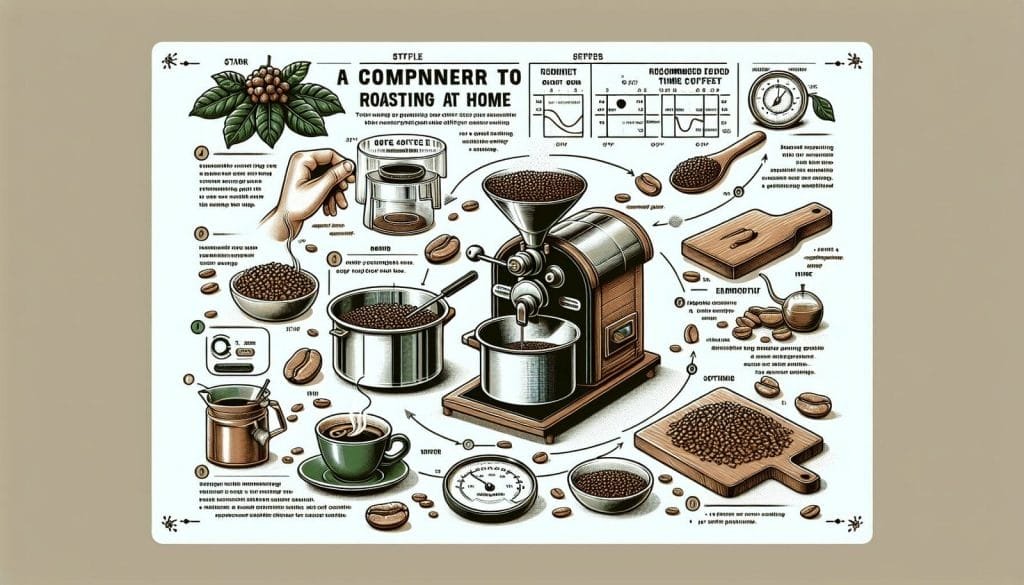So, you’ve recently developed a taste for freshly roasted coffee and you’re thinking, “Why not roast your own beans at home?” Well, the good news is that you’ve come to the right place. In this article, we’ll walk you through the ins and outs of coffee roasting, giving you all the tips and tricks you need to get started on your journey to becoming a home barista extraordinaire. Whether you’re a complete beginner or have dabbled in roasting before, this guide will provide you with all the essential information you need to properly roast coffee at home and unlock the incredible flavors waiting to be discovered within each and every coffee bean. So, grab your apron and let’s get roasting!
Selecting the Right Coffee Beans
When it comes to roasting your own coffee at home, one of the most important steps is selecting the right coffee beans. The quality and origin of the beans you choose will greatly impact the flavor and aroma of your final cup of coffee.
Choosing the right coffee origin
Coffee beans are grown in various regions around the world, each with its unique characteristics and flavors. Understanding the different origins is crucial in selecting the right coffee beans for your taste preferences. Whether you prefer the fruity and floral notes of Ethiopian beans or the rich and chocolatey flavors of beans from Central America, exploring different origins will allow you to find your favorite cup of coffee.
Selecting the appropriate roast level
Another factor to consider when selecting coffee beans is the roast level. Each roast level, from light to dark, brings out different flavors and intensities. Lighter roasts generally showcase the unique characteristics of the beans, while darker roasts tend to have bolder and more robust flavors. Experimenting with different roast levels will help you discover the perfect balance of flavors that suits your taste buds.
Purchasing freshly roasted beans
To ensure the best possible flavor, it is essential to purchase freshly roasted coffee beans. Coffee beans are at their peak in terms of flavor and aroma within a few weeks of being roasted. Look for local coffee roasters or online retailers that prioritize freshness and roast in small batches. By using freshly roasted beans, you’ll be able to experience the true potential of your home-roasted coffee.
Understanding the Roasting Process
Before diving into the actual roasting process, it is important to have a basic understanding of what happens during roasting. Roasting involves subjecting the green coffee beans to heat, causing a series of chemical reactions that transform the flavor, aroma, and color of the beans.
Exploring the chemical changes during roasting
During the roasting process, several chemical changes occur within the coffee beans. These changes, known as the Maillard reaction and caramelization, are responsible for developing the complex flavors and aromas we associate with roasted coffee. The Maillard reaction is a series of chemical reactions between amino acids and reducing sugars, creating the characteristic brown color and developing flavors. Caramelization, on the other hand, occurs when the sugars in the coffee beans are heated, resulting in the familiar sweet and caramel-like notes.
Learning about different roasting methods
There are various methods for roasting coffee, each with its unique set of advantages and challenges. Some popular methods include hot air roasting, drum roasting, and pan roasting. Hot air roasting involves using hot air to evenly roast the beans, while drum roasting utilizes a rotating drum to apply heat. Pan roasting is a more traditional method that involves roasting the beans in a pan over a stove. Each method offers different levels of control and produces distinct flavors, allowing you to experiment and find the technique that suits your preferences.
Identifying the three stages of roasting
The roasting process can be divided into three stages: the drying phase, the browning phase, and the development phase. During the drying phase, the moisture within the beans evaporates, leading to a significant decrease in weight. In the browning phase, the Maillard reaction and caramelization occur, and the beans begin to develop their characteristic flavors and aromas. The development phase is when the flavors fully develop, and the beans reach their desired roast level. Understanding these stages will help you monitor and control the roast process more effectively.

Preparation and Equipment
Before you begin roasting, it is crucial to gather the necessary tools and prepare a suitable workspace to ensure a smooth and successful roasting experience.
Gathering the necessary tools
To roast coffee at home, you will need a few essential tools. A coffee roaster, such as a hot air roaster or popcorn popper specifically designed for roasting coffee, is essential for applying the right heat during the roasting process. Additionally, you’ll need a cooling tray or a colander to cool down the beans after roasting, as well as a dedicated space to store your roasted coffee beans.
Preparing a suitable workspace
Roasting coffee can produce smoke and chaff, so it is crucial to choose a well-ventilated and appropriately sized space for roasting. Ideally, you should set up your workspace near an open window or under a vent hood to extract smoke and ensure proper ventilation. Ensure that the space is clean and free from flammable materials to minimize any potential safety hazards.
Cleaning and calibrating roasting equipment
Before each roast, it is important to clean and calibrate your roasting equipment. This involves removing any residual chaff or leftover coffee beans from previous roasts and ensuring that your equipment is operating correctly. Regular maintenance and cleaning will help extend the lifespan of your roasting equipment and ensure consistent and high-quality roasts.
Determining Roast Profiles
Determining the desired flavor profile for your coffee is a crucial step in the roasting process. A roast profile refers to the specific combination of temperature and time used during roasting, which greatly influences the flavors and characteristics of the coffee.
Defining the desired flavor profile
Before you start roasting, take some time to define the flavor profile that you want to achieve. Consider the balance between acidity, bitterness, sweetness, and body that you prefer in your coffee. Perhaps you enjoy bright and fruity flavors, or maybe you prefer a smoother, more chocolatey profile. Defining your desired flavor profile will guide your roast decisions and help you achieve consistency in your roasts.
Experimenting with different roast profiles
Roasting coffee is a constant learning process, and the best way to improve is through experimentation. Try roasting different batches of coffee beans using different roast profiles. Adjust the roast time and temperature to see how it affects the flavors and aromas of the coffee. Take detailed notes and compare the results to understand the impact of each adjustment on the final cup of coffee. Through experimentation, you’ll be able to refine your techniques and discover your own unique roast profiles.
Understanding the impact of temperature and time
Temperature and time play a critical role in the roasting process and ultimately determine the flavors and characteristics of the coffee. Generally, higher temperatures and shorter roast times will result in lighter roasts, while lower temperatures and longer roast times will yield darker roasts. By manipulating the temperature and time, you can control the development of flavors and experiment with different roast profiles to find the perfect balance.

Safe Roasting Practices
Safety should always be a top priority when roasting coffee at home. Following proper safety practices will not only protect you and your surroundings but also ensure a more enjoyable roasting experience.
Ensuring proper ventilation
As mentioned earlier, proper ventilation is crucial when roasting coffee at home. Ensure that your workspace is well-ventilated, either by setting up near an open window or using a vent hood. Good ventilation will help to remove smoke and minimize any potential health risks associated with inhaling the fumes produced during roasting.
Using protective gear
Wearing appropriate protective gear, such as oven mitts or heat-resistant gloves, is essential during the roasting process. These will protect your hands from accidental burns when handling hot equipment or removing roasted beans from the roasting chamber. Additionally, consider wearing goggles to protect your eyes from chaff or any potential debris that may be released during roasting.
Avoiding common safety hazards
When roasting coffee, it is important to be aware of and avoid common safety hazards. Keep flammable materials, such as paper towels or packaging, away from the roasting equipment to prevent accidental fires. It is also essential to ensure that the roasting chamber is properly sealed and secured to avoid any potential accidents or injuries during the roasting process.
Roasting Techniques
Once you have a good understanding of the basics and have taken the necessary safety precautions, you can explore different roasting techniques to achieve the desired roast level and flavors.
Hot air roasting
Hot air roasting is a popular method among home coffee roasters. It involves using a machine that blows hot air over the coffee beans, creating an evenly roasted batch. Hot air roasting allows for precise control over the roast profile and produces consistent results. This method is ideal for those who prefer lighter roasts and want to highlight the unique characteristics of the coffee beans.
Pan roasting on stovetop
Pan roasting on a stovetop is a traditional method that can be done with basic kitchen equipment. Simply heat a frying pan or skillet, add the green coffee beans, and continuously stir them to ensure even roasting. Pan roasting requires more attention and manual control compared to other methods, but it allows for greater experimentation and a hands-on approach to roasting. This technique is suitable for those who enjoy darker roasts and want to have more control over the roast development.
Using a popcorn popper for roasting
Believe it or not, popcorn poppers can also be repurposed for coffee roasting. Many home coffee roasters have successfully used air poppers designed for making popcorn to roast their coffee beans. The hot air in the popper evenly heats the beans, resulting in a consistent roast. However, it is important to note that not all popcorn poppers are suitable for coffee roasting, so make sure to do your research and select a model that allows for proper temperature control and agitation.

Monitoring and Controlling the Roast
Throughout the roasting process, it is crucial to monitor and control various factors to achieve the desired roast level and flavors.
Observing the color and aroma changes
One of the key indicators of the roasting progress is the color and aroma changes in the coffee beans. As the beans roast, they change from a greenish hue to various shades of brown. It is essential to closely observe the beans and take note of the subtle color changes to determine when the desired roast level has been reached. Additionally, pay attention to the aroma of the beans as it evolves during the roasting process, as this can also provide valuable insights into the roast progress.
Managing the heat source
Controlling the heat source is crucial for maintaining consistent roasting temperatures. Whether you are using a dedicated coffee roaster or a stovetop method, it is important to adjust the heat source accordingly to achieve the desired roast profile. Be mindful of the temperature fluctuations and make necessary adjustments to ensure that the beans are roasted evenly and consistently.
Maintaining a consistent roasting temperature
Consistency is key when it comes to roasting coffee, and maintaining a consistent roasting temperature is essential for achieving reproducible results. Keep track of the temperature throughout the roasting process and make adjustments as needed to ensure that the beans are being roasted at the desired temperature. This will help you achieve consistent flavors and profiles with each batch of roasted coffee.
Cooling and Storing Roasted Coffee
After completing the roast, proper cooling and storage techniques are essential to preserve the flavors and freshness of your freshly roasted coffee.
Understanding the importance of cooling
Cooling the coffee beans rapidly after roasting is crucial to stop the roasting process and prevent overdevelopment. If the beans continue to roast, they can become overly bitter and lose the desirable flavors. By cooling the beans quickly, you can lock in the flavors and aromas developed during the roast, resulting in a more enjoyable cup of coffee.
Using proper cooling methods
There are several methods to cool your roasted coffee beans effectively. One common method is using a cooling tray or a colander. Immediately transfer the roasted beans to the tray or colander and gently toss them to allow for better airflow and cooling. Another method is using a fan to blow cool air onto the beans. Whichever method you choose, ensure that the beans are cooled to room temperature within a few minutes of the roast to preserve the flavors.
Storing roasted coffee for optimal freshness
To maintain the freshness and flavors of your home-roasted coffee, it is important to store the beans properly. Store the roasted beans in an airtight container, away from light, air, and moisture. Consider using opaque containers or ones with airtight seals to prevent exposure to light and oxygen. Avoid storing coffee beans in the refrigerator or freezer, as they can absorb odors and moisture. Instead, store them in a cool, dark pantry or cupboard, and grind the beans just before brewing for the best flavor.

Grinding and Brewing Tips
Once you have roasted and stored your coffee beans, it’s time to grind and brew them to enjoy a delicious cup of coffee.
Choosing the right grinder
Investing in a quality grinder is essential for achieving the best flavor from your freshly roasted coffee beans. Burr grinders are generally preferred over blade grinders, as they provide a consistent grind size, which is crucial for even extraction during brewing. Choose a grinder with adjustable settings to achieve the appropriate grind size for your preferred brewing method.
Finding the optimal grind size
The grind size plays a significant role in the extraction of flavors during brewing. It is important to match the grind size to your chosen brewing method to ensure proper flavor extraction and avoid over-extraction or under-extraction. For example, a coarser grind is suitable for a French press, while a finer grind is needed for espresso. Experiment with different grind sizes until you find the one that achieves the desired flavor in your cup of coffee.
Exploring various brewing methods
There are countless brewing methods to choose from, each offering a unique coffee experience. Whether you prefer the full-bodied richness of a French press or the clean and bright flavors of pour-over, experimenting with different brewing methods will allow you to discover your favorite way to enjoy your home-roasted coffee. Explore tutorials and recipes for different brewing methods to learn about the specific techniques and ratios for each.
Experimenting and Refining Techniques
Roasting coffee at home is a continuous learning process, and there is always room for experimentation and refinement to enhance your skills.
Keeping a coffee roast log
Maintaining a coffee roast log can be a valuable tool for tracking and improving your roasting techniques. Record important details such as the roast profile, batch size, origin of the beans, and any adjustments made during the roast. Additionally, note your observations on the flavor and aroma of each batch. A roast log will help you track your progress, identify patterns, and make informed decisions for future roasts.
Making small adjustments for flavor enhancement
Roasting coffee is all about finding the perfect balance of flavors that suits your taste preferences. As you gain experience, you can make small adjustments to your roast profiles or brewing methods to tease out certain flavors or enhance certain characteristics in your coffee. These adjustments could involve tweaking the temperature, extending or shortening the roast time, or adjusting the grind size. Be patient, and don’t be afraid to experiment to achieve the ultimate cup of coffee that you desire.
Seeking advice from experienced roasters
Learning from experienced roasters or joining coffee roasting communities can greatly accelerate your journey as a home coffee roaster. Seek out advice, tips, and guidance from those who have been roasting coffee for longer. They may provide valuable insights, recommend specific techniques or equipment, and answer any questions you may have. Engaging with other coffee enthusiasts will not only expand your knowledge but will also give you a sense of community and shared passion for coffee.
In conclusion, properly roasting coffee at home requires careful consideration and attention to detail. From selecting the right coffee beans and understanding the roasting process to determining roast profiles and practicing safe roasting techniques, each step is essential in achieving delicious cups of home-roasted coffee. With time, practice, and experimentation, you can refine your techniques and develop your own signature roasts that bring out the best flavors and aromas in your coffee beans. So, roll up your sleeves, gather your tools, and embark on the exciting journey of home coffee roasting!




